Starting to build your kitchen for Japanese cooking? Here is my recommendation for kitchen essentials.
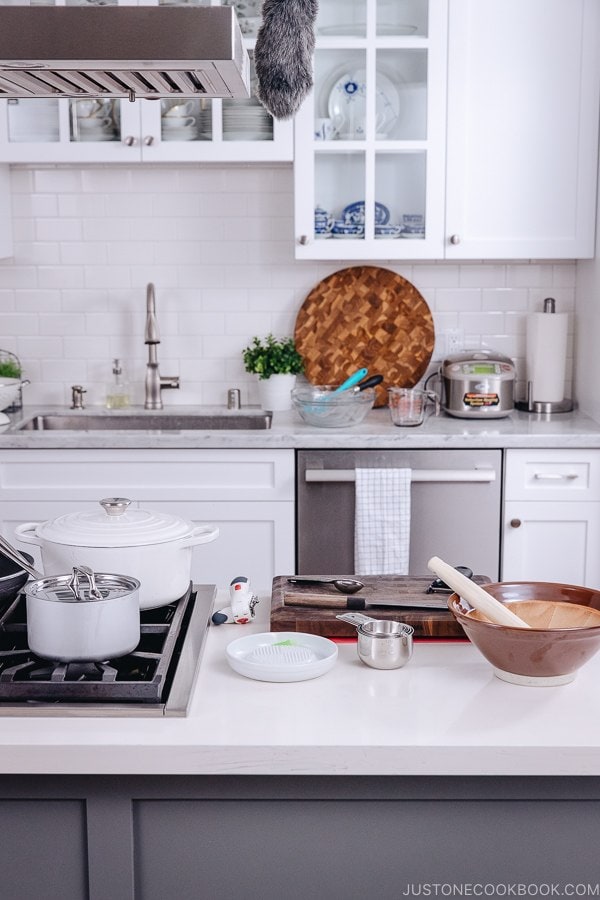
Are you living in a small apartment with limited kitchen space or about to start cooking for the first time? I’m here to provide some tips on how to build a kitchen equipped to cook Japanese food at your own home.
I will cover the essentials in each area of the kitchen. Items in italics are not an absolute “necessity”, but I wanted to include them because I use them often and I think they are worth being included. Whether you prefer a minimalist kitchen or a complete kitchen, this framework will be a great guide for you.
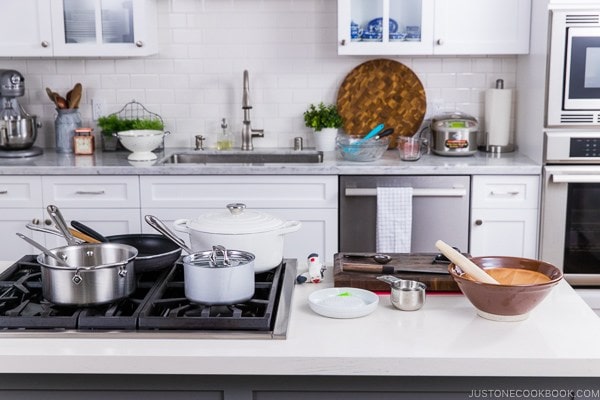
How to Build a Kitchen for Cooking Japanese Food
SINK AREA
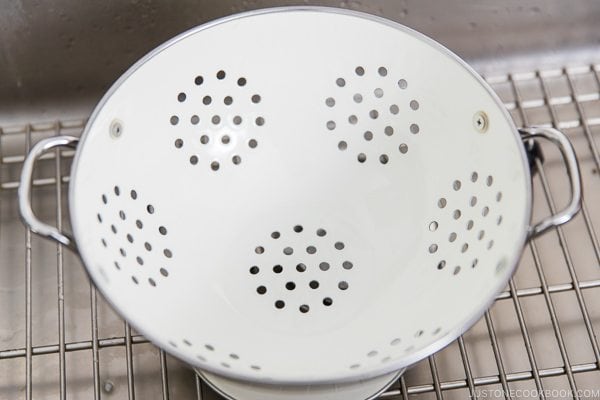
Extra
- A salad spinner (No more diluted dressing!)
STOVETOP
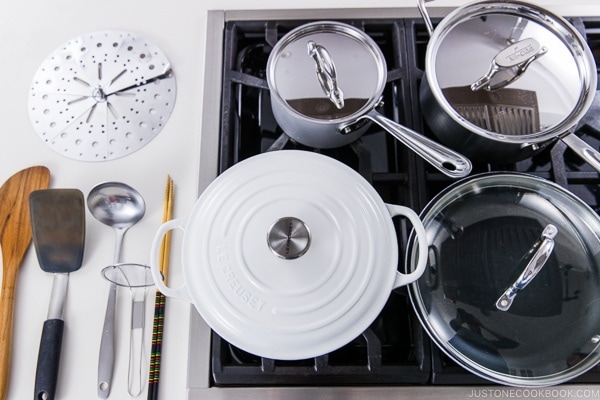
- A large pot (or Dutch oven)
- A medium pot (or Dutch oven)
- A small pot (or Yukihira Nabe)
- A large frying pan or a cast-iron skillet
- A drop lid (otoshibuta) – An essential tool for simmered dishes. Read more here.
- A fine mesh skimmer
- A stainless steel ladle
- A silicone turner spatula
- A wood spatula
- A set of long chopsticks (all-purpose kitchen utensils!)
Extra
CUTTING STATION
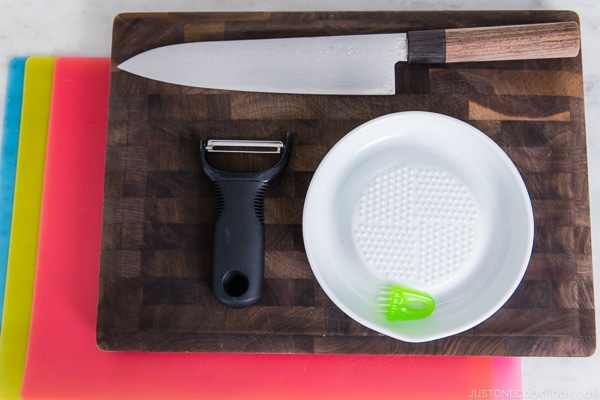
- A wood cutting board
- Plastic cutting board(s) (for meat/seafood)
- A good quality santoku knife
- A vegetable peeler
- A ceramic grater
Extra
WORK AREA
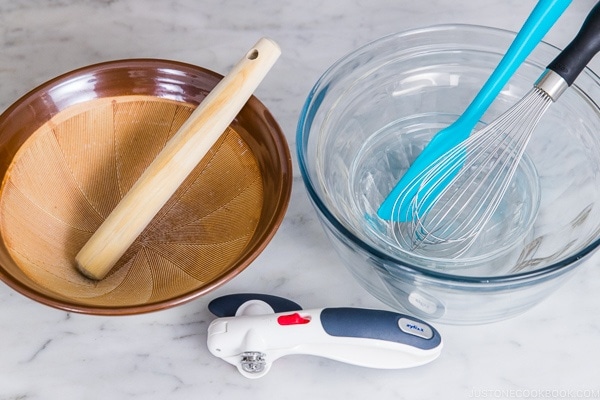
- A set of glass mixing bowls (at least 3 different sizes)
- A set of mortar and pestle
- A silicone spatula
- A large whisk
- A can opener
Extra
- A flat whisk or small whisk
- A cookie scoop (I also use it for savory dishes)
- A garlic press
- A silicone brush
- A pepper grinder
MEASURING TOOLS
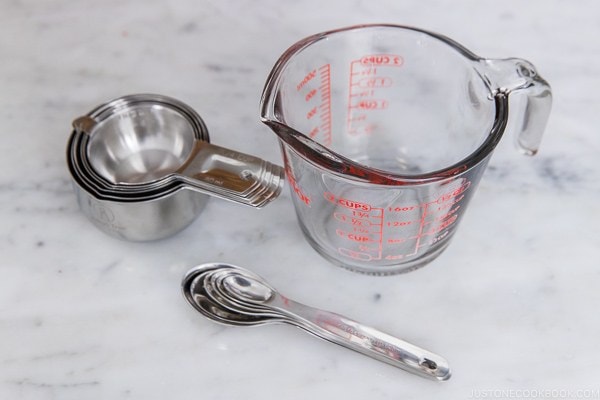
Extra
BAKING
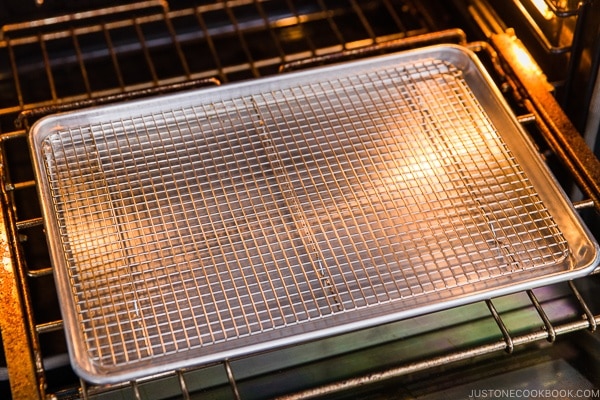
Extra
ELECTRIC GADGETS
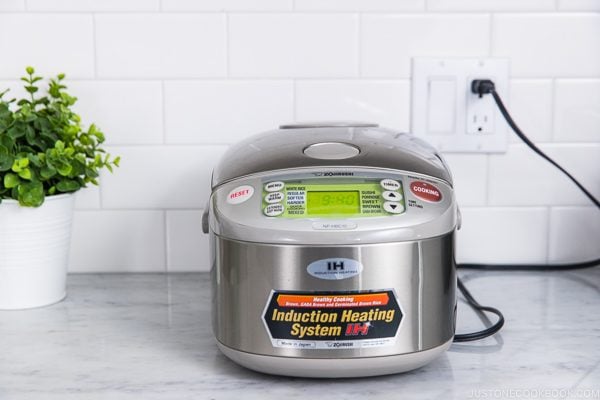
Extra
- A food processor
- A blender
- An Instant Pot (pressure cooker/slow cooker)
JAPANESE RECIPE SPECIFIC (EXTRA)
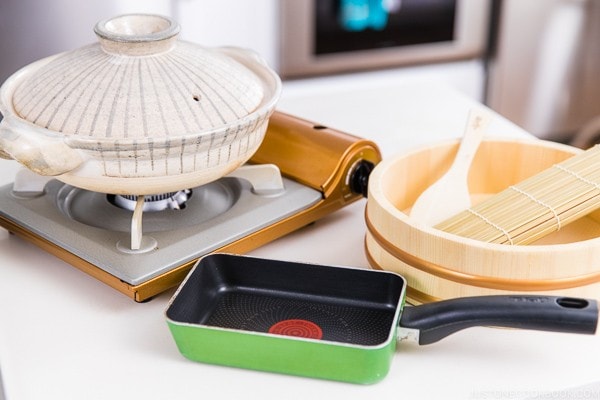
– The kitchen tools below will be useful if you have additional space and will be making specific recipes regularly.
- A donabe (earthenware pot)
- A portable butane stove with butane fuel canister
- A tamagoyaki pan (I used to use the T-fal brand (picture above), but not available on Amazon. I currently use and love this copper Tamagoyaki pan)
- A sushi oke set
TABLEWARE (FOR ONE)
Japanese-style
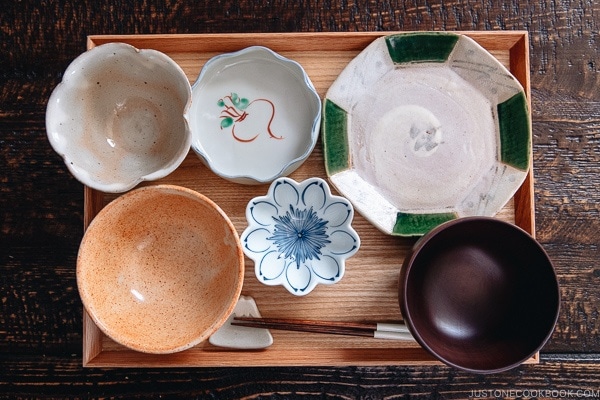
- A rice bowl
- A miso soup bowl
- A medium plate
- A small plate
- A small bowl
- A mini plate
- A set of chopsticks and a chopstick rest
Curious about Japanese tableware? In The Ultimate Guide to Japanese Tableware post, you’ll learn about the important components (what bowls and plates to use, their sizes & functions), and table arrangement on how to set up a Japanese meal.
The Ultimate Guide to Japanese Tableware
Western-style
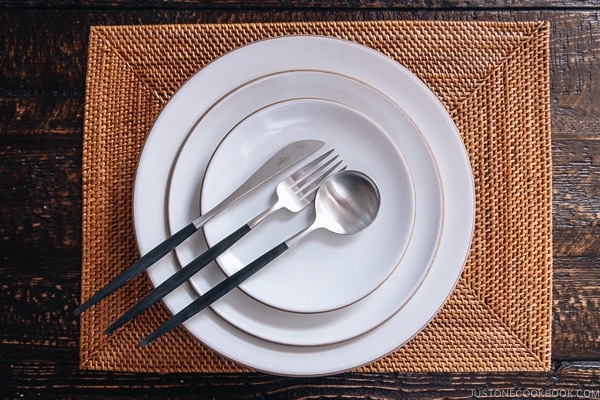
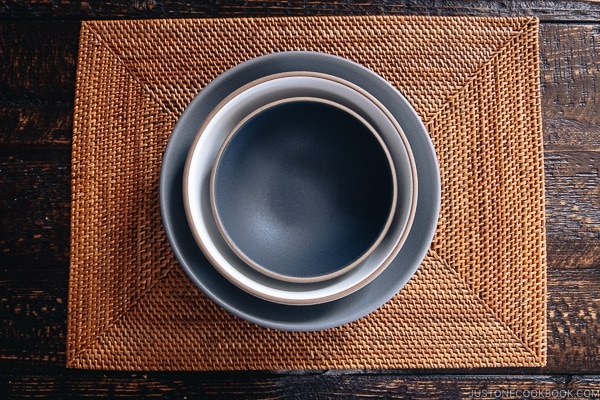
- Large, medium, and small plates
- Large, medium, and small bowls
- Utensils

Additional Tips (For the Minimalist Kitchen)
1. Build your kitchen based on your lifestyle and cooking habits.
When you have a small space to work with, the most important to do is to have an understanding of your preferred living and cooking habits. Ask yourself questions like:
- What kind of recipes will I be making often?
- Do I need this tool? Will I be using it very often?
- Is this going to be just one-time use? etc.
By asking these questions, it will help you to decide what to get and what not to get.
2. Declutter and access your organizing system.
You may have already heard about the famous Mari Kondo method. It is true that there’s magic in tidying up. Although I have a huge collection of cookware for the work that I do, I believe in the power of decluttering and organizing for efficiency.
If you have some clutters in the kitchen, spend some time getting rid of anything that is way too old or no longer in use. This will free up some space for other more important equipment or breathing room. Once you get rid of certain things, start organizing by categories.
2. Think smart storage.
Creativity comes in when you have to maximize the square footage you have. Have a good inspection around your kitchen and look for any potential storage spaces. Is there any space above your fridge? Can you go vertical by hanging things on the wall? You’ll be surprised how much you can utilize the workable room in your tiny kitchen.
I hope the above guide makes your cooking a little easier.
Now it’s your turn! Do you have any kitchen items you can’t live without? Do you have any tips you’d like to share with anyone who lives in a small space? Tell us about it in the comment below.
If you want to check out easy recipes, read 5 Easy Japanese Recipes to Cook At Home.
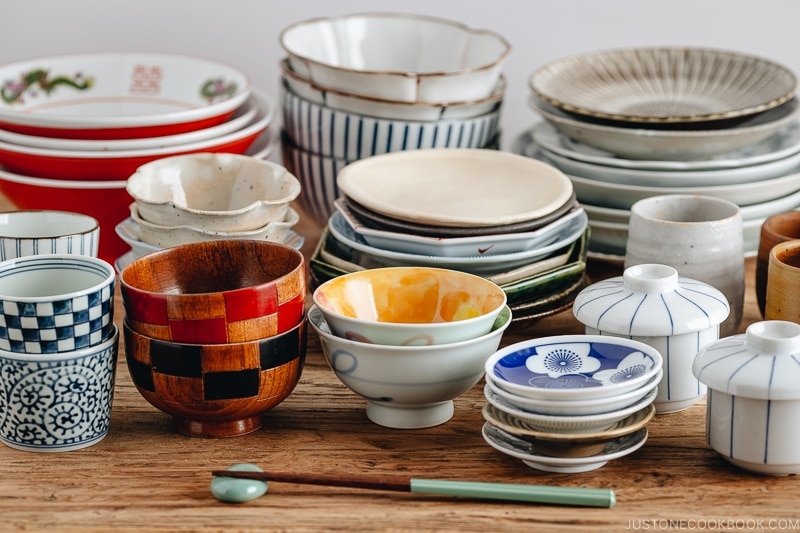










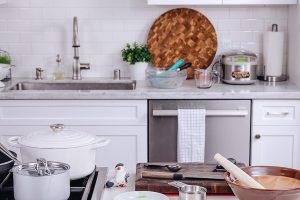
This might be a silly question what sizes are your trays that you use to hold the food?
Hi, Sab! Thank you for reading Nami’s post.
The wooden tray is 13.78″L x 10.24″W.
This link features many of Nami’s favorite goods. Hope this helps! 😊
https://www.amazon.com/shop/justonecookbook
I am looking for a new rice cooker and have my eye on a Zojirushi. They are quite pricey, To justify my purchase I was wondering if there are more things I can use it for besides cooking rice. Thanks in advance.
Hello Becky! How exciting that you’re purchasing a new rice cooker from Zojirushi!
We recommend visiting their website to see the several models they offer. Here are some of the different functions that a rice cooker can perform:
https://www.zojirushi.com/category/rice_cookers/functions.html We hope this helps!😊
On your how-to-build-a-kitchen-for-cooking-japanese-food page under Cutting Station, the link to Santoku Knife is broken. How is a Santoku knife different from a chef’s knife or other kitchen knives?
Hello, Susan! Thank you very much for reading Nami’s post and informing us about the link problem.
Santoku knives are lighter and smaller in size than kitchen knives. In this post, you can learn about and see different knives: https://www.justonecookbook.com/your-guide-to-japanese-knives/
We hope this helps!
Is there a bamboo steamer you could recommend?
Hi MH Syin, Thank you very much for reading Nami’s post!
Nami recommend this one: https://www.amazon.com/dp/B01L9TJCHC?ref=exp_justonecookbook_dp_vv_d
We hope this helps!
Do you have a video / list of how to stock a beginner Japanese pantry?
Hi Allan, Thank you very much for reading Nami’s post.
Currently, we do not have a video for it, but here is a list of posts that we can recommend for you.🙂
https://www.justonecookbook.com/start-here/
https://www.justonecookbook.com/essential-japanese-pantry-ingredients/
https://www.justonecookbook.com/categories/pantry/
We hope this is helpful. Happy Cooking!
I just got two earthen cook pots, and the rest we already have, still working an area to put a butane stove. Thanks again.
Hi Dennis! Wow! That is so exciting!
We hope you enjoy many Donabe recipes from the JOC website.🙂
How do you season a donabe to be used on a open flame?
Hi Theresa, Here is the post link where Nami explains “How To Season Your Donabe (Earthenware Pot)”: https://www.justonecookbook.com/how-to-season-your-donabe/ We hope this is helpful!
It was very helpful. Thank you.
Hi Theresa! You are very welcome! We hope you enjoy the Donabe dish!
Hello,
Great Article, I was looking for something like this for awhile, because I prefer Japanese food far over Chinese. What are the spices and sauces that are required that I should purchase, as well as the necessary ingredients bean sprouts, hearts of palm, or the special mushrooms, etc. Also a Wok is not required?
Best Regards,
Anthony
Hi Anthony, Thank you very much for reading this post and for your kind feedback. Here is the post link where Nami explains in detail about Japanese ingredients and links to each recipe.
https://www.justonecookbook.com/start-here/ (please click “How to Build a Basic Japanese Pantry” in the index)
https://www.justonecookbook.com/categories/pantry/
We hope this is helpful and soon you can enjoy cooking Japanese food! As for the Wok, it’s not required to make Japanese food, but nice to have it if you are cooking Japanese style Chinese dishes.🙂